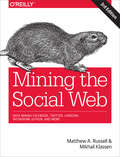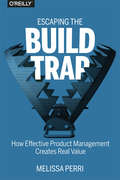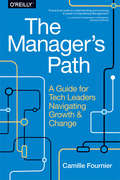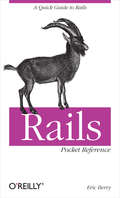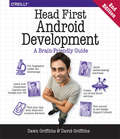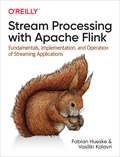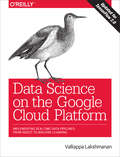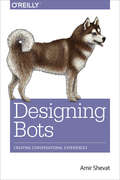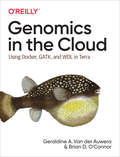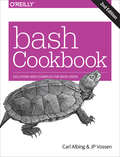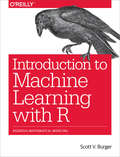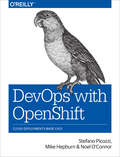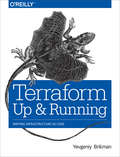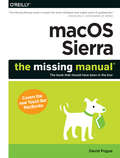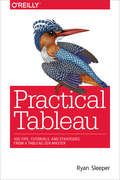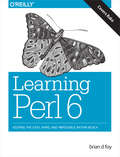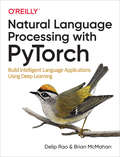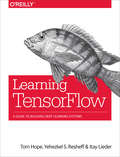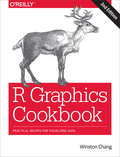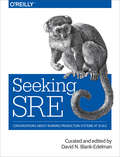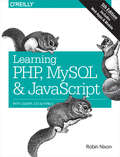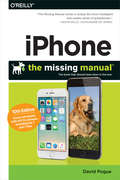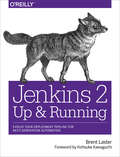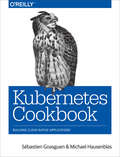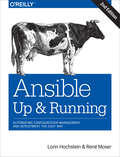- Table View
- List View
Mining the Social Web: Data Mining Facebook, Twitter, LinkedIn, Instagram, GitHub, and More
by Matthew A. Russell Mikhail KlassenMine the rich data tucked away in popular social websites such as Twitter, Facebook, LinkedIn, and Instagram. With the third edition of this popular guide, data scientists, analysts, and programmers will learn how to glean insights from social media—including who’s connecting with whom, what they’re talking about, and where they’re located—using Python code examples, Jupyter notebooks, or Docker containers.In part one, each standalone chapter focuses on one aspect of the social landscape, including each of the major social sites, as well as web pages, blogs and feeds, mailboxes, GitHub, and a newly added chapter covering Instagram. Part two provides a cookbook with two dozen bite-size recipes for solving particular issues with Twitter.Get a straightforward synopsis of the social web landscapeUse Docker to easily run each chapter’s example code, packaged as a Jupyter notebookAdapt and contribute to the code’s open source GitHub repositoryLearn how to employ best-in-class Python 3 tools to slice and dice the data you collectApply advanced mining techniques such as TFIDF, cosine similarity, collocation analysis, clique detection, and image recognitionBuild beautiful data visualizations with Python and JavaScript toolkits
Escaping the Build Trap: How Effective Product Management Creates Real Value
by Melissa PerriTo stay competitive in today’s market, organizations need to adopt a culture of customer-centric practices that focus on outcomes rather than outputs. Companies that live and die by outputs often fall into the "build trap," cranking out features to meet their schedule rather than the customer’s needs.In this book, Melissa Perri explains how laying the foundation for great product management can help companies solve real customer problems while achieving business goals. By understanding how to communicate and collaborate within a company structure, you can create a product culture that benefits both the business and the customer. You’ll learn product management principles that can be applied to any organization, big or small.In five parts, this book explores:Why organizations ship features rather than cultivate the value those features representHow to set up a product organization that scalesHow product strategy connects a company’s vision and economic outcomes back to the product activitiesHow to identify and pursue the right opportunities for producing value through an iterative product frameworkHow to build a culture focused on successful outcomes over outputs
The Manager's Path: A Guide for Tech Leaders Navigating Growth and Change
by Camille FournierManaging people is difficult wherever you work. But in the tech industry, where management is also a technical discipline, the learning curve can be brutal—especially when there are few tools, texts, and frameworks to help you. In this practical guide, author Camille Fournier (tech lead turned CTO) takes you through each stage in the journey from engineer to technical manager.From mentoring interns to working with senior staff, you’ll get actionable advice for approaching various obstacles in your path. This book is ideal whether you’re a new manager, a mentor, or a more experienced leader looking for fresh advice. Pick up this book and learn how to become a better manager and leader in your organization.Begin by exploring what you expect from a managerUnderstand what it takes to be a good mentor, and a good tech leadLearn how to manage individual members while remaining focused on the entire teamUnderstand how to manage yourself and avoid common pitfalls that challenge many leadersManage multiple teams and learn how to manage managersLearn how to build and bootstrap a unifying culture in teams
Rails Pocket Reference: A Quick Guide to Rails
by Eric BerryRails 2.1 brings a new level of stability and power to this acclaimed web development framework, but keeping track of its numerous moving parts is still a chore. Rails Pocket Reference offers you a painless alternative to hunting for resources online, with brief yet thorough explanations of the most frequently used methods and structures supported by Rails 2.1, along with key concepts you need to work through the framework's most tangled corners.Organized to help you quickly find what you need, this book will not only get you up to speed on how Rails works, it also provides a handy reference you can use anywhere, anytime. Inside, you'll find essential information on how to:Install Rails with RubyGemsBuild, compile, and process files with RakeTest Rails applications using assertions and fixturesUse Rails with AjaxConnect objects to a database using ActiveRecordMake web requests with the Action Controller frameworkUse REST web service APIsAnd much more. Save yourself hours of frustration: If you use Rails daily and just want the facts -- fast -- this is your book.
Head First Android Development: A Brain-Friendly Guide
by David Griffiths Dawn GriffithsWhat will you learn from this book?If you have an idea for a killer Android app, this fully revised and updated edition will help you build your first working application in a jiffy. You’ll learn hands-on how to structure your app, design flexible and interactive interfaces, run services in the background, make your app work on various smartphones and tablets, and much more. It’s like having an experienced Android developer sitting right next to you! All you need to get started is some Java know-how.Why does this book look so different?Based on the latest research in cognitive science and learning theory, Head First Android Development uses a visually rich format to engage your mind, rather than a text-heavy approach that puts you to sleep. Why waste your time struggling with new concepts? This multi-sensory learning experience is designed for the way your brain really works.
Stream Processing with Apache Flink: Fundamentals, Implementation, and Operation of Streaming Applications
by Vasiliki Kalavri Fabian HueskeGet started with Apache Flink, the open source framework that powers some of the world’s largest stream processing applications. With this practical book, you’ll explore the fundamental concepts of parallel stream processing and discover how this technology differs from traditional batch data processing.Longtime Apache Flink committers Fabian Hueske and Vasia Kalavri show you how to implement scalable streaming applications with Flink’s DataStream API and continuously run and maintain these applications in operational environments. Stream processing is ideal for many use cases, including low-latency ETL, streaming analytics, and real-time dashboards as well as fraud detection, anomaly detection, and alerting. You can process continuous data of any kind, including user interactions, financial transactions, and IoT data, as soon as you generate them.Learn concepts and challenges of distributed stateful stream processingExplore Flink’s system architecture, including its event-time processing mode and fault-tolerance modelUnderstand the fundamentals and building blocks of the DataStream API, including its time-based and statefuloperatorsRead data from and write data to external systems with exactly-once consistencyDeploy and configure Flink clustersOperate continuously running streaming applications
Data Science on the Google Cloud Platform: Implementing End-to-End Real-Time Data Pipelines: From Ingest to Machine Learning
by Valliappa LakshmananLearn how easy it is to apply sophisticated statistical and machine learning methods to real-world problems when you build on top of the Google Cloud Platform (GCP). This hands-on guide shows developers entering the data science field how to implement an end-to-end data pipeline, using statistical and machine learning methods and tools on GCP. Through the course of the book, you’ll work through a sample business decision by employing a variety of data science approaches.Follow along by implementing these statistical and machine learning solutions in your own project on GCP, and discover how this platform provides a transformative and more collaborative way of doing data science.You’ll learn how to:Automate and schedule data ingest, using an App Engine applicationCreate and populate a dashboard in Google Data StudioBuild a real-time analysis pipeline to carry out streaming analyticsConduct interactive data exploration with Google BigQueryCreate a Bayesian model on a Cloud Dataproc clusterBuild a logistic regression machine-learning model with SparkCompute time-aggregate features with a Cloud Dataflow pipelineCreate a high-performing prediction model with TensorFlowUse your deployed model as a microservice you can access from both batch and real-time pipelines
Designing Bots: Creating Conversational Experiences
by Amir ShevatFrom Facebook Messenger to Kik, and from Slack bots to Google Assistant, Amazon Alexa, and email bots, the new conversational apps are revolutionizing the way we interact with software. This practical guide shows you how to design and build great conversational experiences and delightful bots that help people be more productive, whether it’s for a new consumer service or an enterprise efficiency product.Ideal for designers, product managers, and entrepreneurs, this book explores what works and what doesn’t in real-world bot examples, and provides practical design patterns for your bot-building toolbox. You’ll learn how to use an effective onboarding process, outline different flows, define a bot personality, and choose the right balance of rich control and text.Explore different bot use-cases and design best practicesUnderstand bot anatomy—such as brand and personality, conversations, advanced UI controls—and their associated design patternsLearn steps for building a Facebook Messenger consumer bot and a Slack business botExplore the lessons learned and shared experiences of designers and entrepreneurs who have built botsDesign and prototype your first bot, and experiment with user feedback
Genomics in the Cloud: Using Docker, GATK, and WDL in Terra
by Brian O'Connor Geraldine A. Van der AuweraData in the genomics field is booming. In just a few years, organizations such as the National Institutes of Health (NIH) will host 50+ petabytes—or over 50 million gigabytes—of genomic data, and they’re turning to cloud infrastructure to make that data available to the research community. How do you adapt analysis tools and protocols to access and analyze that volume of data in the cloud?With this practical book, researchers will learn how to work with genomics algorithms using open source tools including the Genome Analysis Toolkit (GATK), Docker, WDL, and Terra. Geraldine Van der Auwera, longtime custodian of the GATK user community, and Brian O’Connor of the UC Santa Cruz Genomics Institute, guide you through the process. You’ll learn by working with real data and genomics algorithms from the field. <p><p>This book covers: <li>Essential genomics and computing technology background <li>Basic cloud computing operations <li>Getting started with GATK, plus three major GATK Best Practices pipelines <li>Automating analysis with scripted workflows using WDL and Cromwell <li>Scaling up workflow execution in the cloud, including parallelization and cost optimization <li>Interactive analysis in the cloud using Jupyter notebooks <li>Secure collaboration and computational reproducibility using Terra
bash Cookbook: Solutions and Examples for bash Users
by Carl Albing Jp VossenFor system administrators, programmers, and end users, shell command or carefully crafted shell script can save you time and effort, or facilitate consistency and repeatability for a variety of common tasks. This cookbook provides more than 300 practical recipes for using bash, the popular Unix shell that enables you to harness and customize the power of any Unix or Linux system.Ideal for new and experienced users alike—including proficient Windows users and sysadmins—this updated second edition helps you solve a wide range of problems. You’ll learn ways to handle input/output, file manipulation, program execution, administrative tasks, and many other challenges. Each recipe includes one or more scripting examples and a discussion of why the solution works.You’ll find recipes for problems including:Standard output and input, and executing commandsShell variables, shell logic, and arithmeticIntermediate shell tools and advanced scriptingSearching for files with find, locate, and slocateWorking with dates and timesCreating shell scripts for various end-user tasksWorking with tasks that require parsingWriting secure shell scriptsConfiguring and customizing bash
Introduction to Machine Learning with R: Rigorous Mathematical Analysis
by Scott V. BurgerMachine learning is an intimidating subject until you know the fundamentals. If you understand basic coding concepts, this introductory guide will help you gain a solid foundation in machine learning principles. Using the R programming language, you’ll first start to learn with regression modelling and then move into more advanced topics such as neural networks and tree-based methods.Finally, you’ll delve into the frontier of machine learning, using the caret package in R. Once you develop a familiarity with topics such as the difference between regression and classification models, you’ll be able to solve an array of machine learning problems. Author Scott V. Burger provides several examples to help you build a working knowledge of machine learning.Explore machine learning models, algorithms, and data trainingUnderstand machine learning algorithms for supervised and unsupervised casesExamine statistical concepts for designing data for use in modelsDive into linear regression models used in business and scienceUse single-layer and multilayer neural networks for calculating outcomesLook at how tree-based models work, including popular decision treesGet a comprehensive view of the machine learning ecosystem in RExplore the powerhouse of tools available in R’s caret package
DevOps with OpenShift: Cloud Deployments Made Easy
by Mike Hepburn Noel O'Connor Stefano PicozziFor many organizations, a big part of DevOps’ appeal is software automation using infrastructure-as-code techniques. This book presents developers, architects, and infra-ops engineers with a more practical option. You’ll learn how a container-centric approach from OpenShift, Red Hat’s cloud-based PaaS, can help your team deliver quality software through a self-service view of IT infrastructure.Three OpenShift experts at Red Hat explain how to configure Docker application containers and the Kubernetes cluster manager with OpenShift’s developer- and operational-centric tools. Discover how this infrastructure-agnostic container management platform can help companies navigate the murky area where infrastructure-as-code ends and application automation begins.Get an application-centric view of automation—and understand why it’s importantLearn patterns and practical examples for managing continuous deployments such as rolling, A/B, blue-green, and canaryImplement continuous integration pipelines with OpenShift’s Jenkins capabilityExplore mechanisms for separating and managing configuration from static runtime softwareLearn how to use and customize OpenShift’s source-to-image capabilityDelve into management and operational considerations when working with OpenShift-based application workloadsInstall a self-contained local version of the OpenShift environment on your computer
Terraform: Writing Infrastructure as Code
by Yevgeniy BrikmanTerraform has emerged as a key player in the DevOps world for defining, launching, and managing infrastructure as code (IAC) across a variety of cloud and virtualization platforms, including AWS, Google Cloud, and Azure. This hands-on book is the fastest way to get up and running with Terraform.Gruntwork co-founder Yevgeniy (Jim) Brikman walks you through dozens of code examples that demonstrate how to use Terraform’s simple, declarative programming language to deploy and manage infrastructure with just a few commands. Whether you’re a novice developer, aspiring DevOps engineer, or veteran sysadmin, this book will take you from Terraform basics to running a full tech stack capable of supporting a massive amount of traffic and a large team of developers.Compare Terraform to other IAC tools, such as Chef, Puppet, Ansible, and Salt StackUse Terraform to deploy server clusters, load balancers, and databasesLearn how Terraform manages the state of your infrastructure and how it impacts file layout, isolation, and lockingCreate reusable infrastructure with Terraform modulesTry out advanced Terraform syntax to implement loops, if-statements, and zero-downtime deploymentUse Terraform as a team, including best practices for writing, testing, and versioning Terraform code
macOS Sierra: The book that should have been in the box
by David PogueWith Sierra, Apple brings never-before-seen features to macOS--like Siri voice control, file sharing across all your iOS devices, picture-in-picture mode for iTunes and Safari, and AI photo search. Once again, David Pogue brings his humor and expertise to the #1 bestselling Mac book.Whether you're a developer or a home-user, this guide offers a wealth of detail on Apple's OS X 10.12 operating system, this new edition covers everything Sierra has to offer.Perfect for newcomers. Get crystal-clear, jargon-free introduction to the Dock, the macOS folder structure, Safari, Mail, and iCloud.Go in-depth. Learn how to use key new features such as Optimized Storage, the Universal Clipboard, Siri for Mac, and iCloud Drive Sync.Get the full story. David Pogue doesn't stop at telling you how to use macOS features. He wants you to know why to use them--and how to avoid common pitfalls.
Practical Tableau: 100 Tips, Tutorials, and Strategies from a Tableau Zen Master
by Ryan SleeperWhether you have some experience with Tableau software or are just getting started, this manual goes beyond the basics to help you build compelling, interactive data visualization applications. Author Ryan Sleeper, one of the world’s most qualified Tableau consultants, complements his web posts and instructional videos with this guide to give you a firm understanding of how to use Tableau to find valuable insights in data.Over five sections, Sleeper—recognized as a Tableau Zen Master, Tableau Public Visualization of the Year author, and Tableau Iron Viz Champion—provides visualization tips, tutorials, and strategies to help you avoid the pitfalls and take your Tableau knowledge to the next level.Practical Tableau sections include:Fundamentals: get started with Tableau from the beginningChart types: use step-by-step tutorials to build a variety of charts in TableauTips and tricks: learn innovative uses of parameters, color theory, how to make your Tableau workbooks run efficiently, and moreFramework: explore the INSIGHT framework, a proprietary process for building Tableau dashboardsStorytelling: learn tangible tactics for storytelling with data, including specific and actionable tips you can implement immediately
Learning Perl 6: Keeping the Easy, Hard, and Impossible Within Reach
by Brian D FoyIf you’re ready to get started with Perl 6, this is the book you want, whether you’re a programmer, system administrator, or web hacker. Perl 6 is a new language—a modern reinvention of Perl suitable for almost any task, from short fixes to complete web applications. This hands-on tutorial gets you started.Author brian d foy (Mastering Perl) provides a sophisticated introduction to this new programming language. Each chapter in this guide contains exercises to help you practice what you learn as you learn it. Other books may teach you to program in Perl 6, but this book will turn you into a Perl 6 programmer.Learn how to work with:Numbers, strings, blocks, and positionalsFiles and directories and input/outputAssociatives, subroutines, classes, and rolesJunctions and setsRegular expressions and built-in grammarsConcurrency features: Promises, supplies, and channelsControlling external programs and other advanced features
Natural Language Processing with PyTorch: Build Intelligent Language Applications Using Deep Learning
by Delip Rao Brian McMahanNatural Language Processing (NLP) provides boundless opportunities for solving problems in artificial intelligence, making products such as Amazon Alexa and Google Translate possible. If you’re a developer or data scientist new to NLP and deep learning, this practical guide shows you how to apply these methods using PyTorch, a Python-based deep learning library.Authors Delip Rao and Brian McMahon provide you with a solid grounding in NLP and deep learning algorithms and demonstrate how to use PyTorch to build applications involving rich representations of text specific to the problems you face. Each chapter includes several code examples and illustrations.Explore computational graphs and the supervised learning paradigmMaster the basics of the PyTorch optimized tensor manipulation libraryGet an overview of traditional NLP concepts and methodsLearn the basic ideas involved in building neural networksUse embeddings to represent words, sentences, documents, and other featuresExplore sequence prediction and generate sequence-to-sequence modelsLearn design patterns for building production NLP systems
Learning TensorFlow: A Guide to Building Deep Learning Systems
by Itay Lieder Tom Hope Yehezkel S. ResheffRoughly inspired by the human brain, deep neural networks trained with large amounts of data can solve complex tasks with unprecedented accuracy. This practical book provides an end-to-end guide to TensorFlow, the leading open source software library that helps you build and train neural networks for computer vision, natural language processing (NLP), speech recognition, and general predictive analytics.Authors Tom Hope, Yehezkel Resheff, and Itay Lieder provide a hands-on approach to TensorFlow fundamentals for a broad technical audience—from data scientists and engineers to students and researchers. You’ll begin by working through some basic examples in TensorFlow before diving deeper into topics such as neural network architectures, TensorBoard visualization, TensorFlow abstraction libraries, and multithreaded input pipelines. Once you finish this book, you’ll know how to build and deploy production-ready deep learning systems in TensorFlow.Get up and running with TensorFlow, rapidly and painlesslyLearn how to use TensorFlow to build deep learning models from the ground upTrain popular deep learning models for computer vision and NLPUse extensive abstraction libraries to make development easier and fasterLearn how to scale TensorFlow, and use clusters to distribute model trainingDeploy TensorFlow in a production setting
R Graphics Cookbook: Practical Recipes for Visualizing Data
by Winston ChangThis O’Reilly cookbook provides more than 150 recipes to help scientists, engineers, programmers, and data analysts generate high-quality graphs quickly—without having to comb through all the details of R’s graphing systems. Each recipe tackles a specific problem with a solution you can apply to your own project and includes a discussion of how and why the recipe works.Most of the recipes in this second edition use the updated version of the ggplot2 package, a powerful and flexible way to make graphs in R. You’ll also find expanded content about the visual design of graphics. If you have at least a basic understanding of the R language, you’re ready to get started with this easy-to-use reference.Use R’s default graphics for quick exploration of dataCreate a variety of bar graphs, line graphs, and scatter plotsSummarize data distributions with histograms, density curves, box plots, and moreProvide annotations to help viewers interpret dataControl the overall appearance of graphicsExplore options for using colors in plotsCreate network graphs, heat maps, and 3D scatter plotsGet your data into shape using packages from the tidyverse
Seeking SRE: Conversations About Running Production Systems at Scale
by David N. Blank-EdelmanOrganizations big and small have started to realize just how crucial system and application reliability is to their business. They’ve also learned just how difficult it is to maintain that reliability while iterating at the speed demanded by the marketplace. Site Reliability Engineering (SRE) is a proven approach to this challenge.SRE is a large and rich topic to discuss. Google led the way with Site Reliability Engineering, the wildly successful O’Reilly book that described Google’s creation of the discipline and the implementation that’s allowed them to operate at a planetary scale. Inspired by that earlier work, this book explores a very different part of the SRE space. The more than two dozen chapters in Seeking SRE bring you into some of the important conversations going on in the SRE world right now.Listen as engineers and other leaders in the field discuss:Different ways of implementing SRE and SRE principles in a wide variety of settingsHow SRE relates to other approaches such as DevOpsSpecialties on the cutting edge that will soon be commonplace in SREBest practices and technologies that make practicing SRE easierThe important but rarely explored human side of SREDavid N. Blank-Edelman is the book’s curator and editor.
Learning PHP, MySQL & JavaScript: With jQuery, CSS & HTML5 (Animal Guide Ser.)
by Robin NixonBuild interactive, data-driven websites with the potent combination of open source technologies and web standards, even if you have only basic HTML knowledge. In this update to this popular hands-on guide, you’ll tackle dynamic web programming with the latest versions of today’s core technologies: PHP, MySQL, JavaScript, CSS, HTML5, and key jQuery libraries.Web designers will learn how to use these technologies together and pick up valuable web programming practices along the way—including how to optimize websites for mobile devices. At the end of the book, you’ll put everything together to build a fully functional social networking site suitable for both desktop and mobile browsers.Explore MySQL, from database structure to complex queriesUse the MySQLi extension, PHP’s improved MySQL interfaceCreate dynamic PHP web pages that tailor themselves to the userManage cookies and sessions and maintain a high level of securityEnhance the JavaScript language with jQuery and jQuery mobile librariesUse Ajax calls for background browser-server communicationStyle your web pages by acquiring CSS2 and CSS3 skillsImplement HTML5 features, including geolocation, audio, video, and the canvas elementReformat your websites into mobile web apps
iPhone: The book that should have been in the box
by David PogueiOS 10 for the iPhone includes a host of exciting new features—including an all-new Messages app, updates to Maps, Search, 3D Touch, and widgets. And the iPhone 7 and 7 Plus have new, more advanced cameras, and you can do more with Siri and third-party apps than ever before.What’s the best way to learn all of these features? iPhone: The Missing Manual is a funny, gorgeously illustrated guide to the tips, shortcuts, and workarounds that will turn you, too, into an iPhone master. This easy-to-use book will help you accomplish everything from web browsing to watching videos so you can get the most out of your iPhone.Written by Missing Manual series creator and former New York Times columnist David Pogue, this updated guide shows you everything you need to know about the new features and user interface of iOS 10 for the iPhone.
Jenkins 2: Evolve Your Deployment Pipeline for Next Generation Automation
by Brent LasterDesign, implement, and execute continuous delivery pipelines with a level of flexibility, control, and ease of maintenance that was not possible with Jenkins before. With this practical book, build administrators, developers, testers, and other professionals will learn how the features in Jenkins 2 let you define pipelines as code, leverage integration with other key technologies, and create automated, reliable pipelines to simplify and accelerate your DevOps environments.Author Brent Laster shows you how Jenkins 2 is significantly different from the more traditional, web-only versions of this popular open source automation platform. If you’re familiar with Jenkins and want to take advantage of the new technologies to transform your legacy pipelines or build new modern, automated continuous delivery environments, this is your book.Create continuous delivery pipelines as code with the Jenkins domain-specific languageGet practical guidance on how to migrate existing jobs and pipelinesHarness best practices and new methods for controlling access and securityExplore the structure, implementation, and use of shared pipeline librariesLearn the differences between declarative syntax and scripted syntaxLeverage new and existing project types in JenkinsUnderstand and use the new Blue Ocean graphical interfaceTake advantage of the capabilities of the underlying OS in your pipelineIntegrate analysis tools, artifact management, and containers
Kubernetes Cookbook: Building Cloud Native Applications
by Sébastien Goasguen Michael HausenblasKubernetes is becoming the de-facto standard for container orchestration and distributed applications management across a microservices framework. With this practical cookbook, you’ll learn hands-on recipes for automating the deployment, scaling, and operations of application containers across clusters of hosts.The book's easy-lookup problem-solution-discussion format helps you find the detailed answers you need—quickly. Kubernetes lets you deploy your applications quickly and predictably, so you can efficiently respond to customer demand. This cookbook, ideal for developers and system administers alike, provides the essential knowledge you need to get there. You’ll find recipes for :Kubernetes installation, Kubernetes API, API groups, Application primitives, Monitoring Troubleshooting
Ansible Up and Running: Automating Configuration Management and Deployment the Easy Way (2nd Edition)
by Lorin Hochstein Rene MoserAmong the many configuration management tools available, Ansible has some distinct advantages—it’s minimal in nature, you don’t need to install anything on your nodes, and it has an easy learning curve. With this updated second edition, you’ll learn how to be productive with this tool quickly, whether you’re a developer deploying code to production or a system administrator looking for a better automation solution.Authors Lorin Hochstein and René Moser show you how to write playbooks (Ansible’s configuration management scripts), manage remote servers, and explore the tool’s real power: built-in declarative modules. You’ll discover that Ansible has the functionality you need—and the simplicity you desire.Manage Windows machines, and automate network device configurationManage your fleet from your web browser with Ansible TowerUnderstand how Ansible differs from other configuration management systemsUse the YAML file format to write your own playbooksWork with a complete example to deploy a non-trivial applicationDeploy applications to Amazon EC2 and other cloud platformsCreate Docker images and deploy Docker containers with AnsibleThis book is best read start to finish, with later chapters building on earlier ones. Because it’s written in a tutorial style, you can follow along on your own machine. Most examples focus on web applications.
